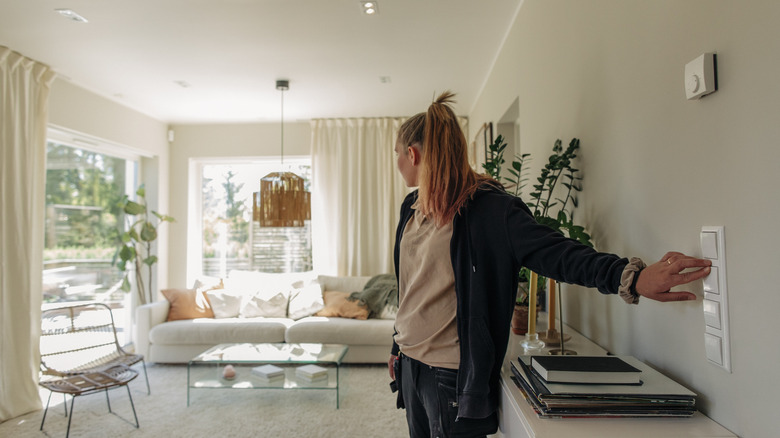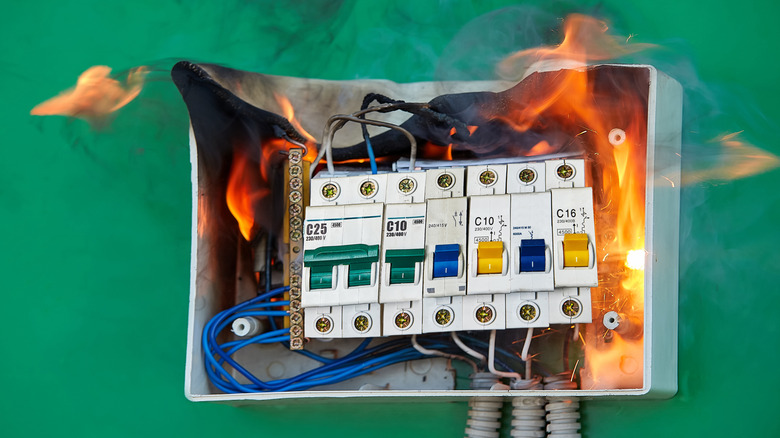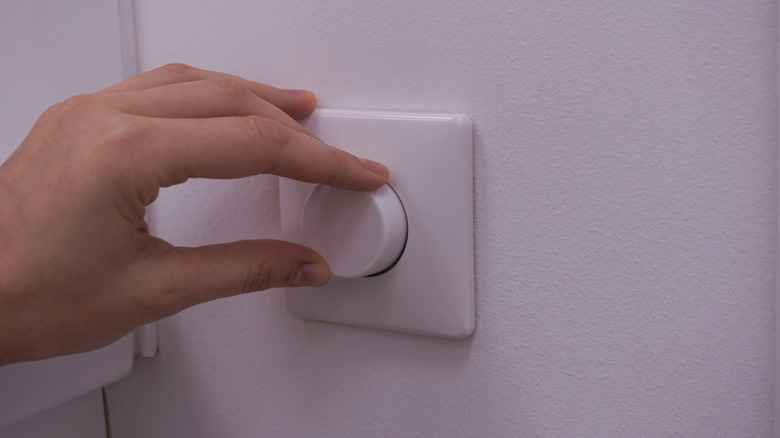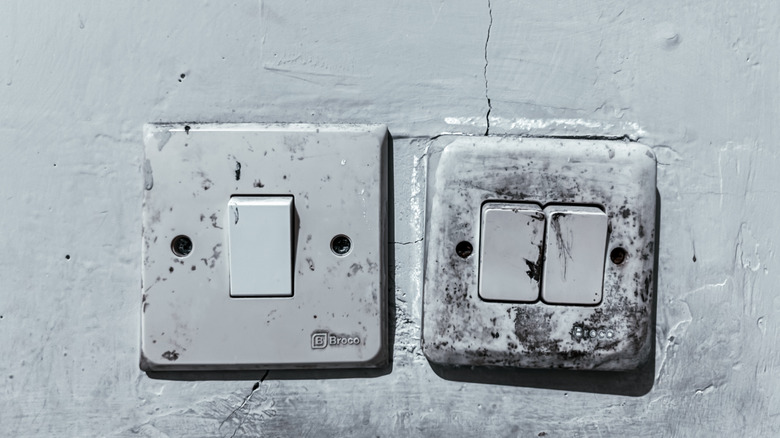5 Possible Reasons Why Your Light Switch Is Buzzing (And How To Fix It)
Managing the complex systems of the modern home can become pretty tricky. While mowing the lawn and hanging pictures on the wall are relatively straightforward tasks, plenty of additional complications can make those and more positively headache-inducing (there's one particular Harbor Freight product that can help with hanging things on cavity walls without needing to find a stud, for instance).
Electrical work is a uniquely squirrely part of home maintenance and gets many people twisted up. Sometimes an electrical installation or repair job is easy, and other times might feel simple but almost certainly demand the help of a professional. As is always the case with potentially dangerous systems, calling on the help of someone with specialized knowledge is frequently the best approach. Personally, I have plenty of experience rewiring light switches, adding sockets, and more, but there are still plenty of electrical jobs I defer to the experts on.
A buzzing light switch is the perfect example of a seemingly easy electrical fix. There are lots of underlying conditions that can result in a buzzing sound that begins to emanate from your switch. Some are easy to fix on your own, while others can be hazardous or involve complicated solutions that the average homeowner isn't prepared to navigate. These are five of the most common reasons for a light switch buzz, and what you can do about each one.
Incompatible bulb types
The incandescent bulb was patented in 1879 (and again in 1880) by Thomas Edison. It quickly became the illumination tool of choice throughout American households and then the entire world. Back in these days, homes were arranged in a different orientation. The earliest advancements in television history came around the same time, but it would be many years before the standard living room would revolve around a television set mounted to the wall or placed upon a dedicated piece of furniture (with the same being said for other electrical additions). As a result, some of the earliest introductions of electric power into the household were centered on the installation of electric light.
However, LED and other light technologies have long since picked where incandescent bulbs left off, and properties with older electrical systems may not be equipped with LED-friendly switches and other installations. The wattage is different and there may ultimately be a mismatch that causes unwanted feedback. Components may be pushed past their limits and one common result of this phenomenon is a buzzing sound. Changing the bulb is something you can do on your own, but you may want to consult with a professional if you are unsure about the compatibility of your switch with a light bulb that you desire. And while changing the switch itself is not a difficult task either, selecting one that ensures proper function across the connection can be a little trickier.
Your switch is wired loosely
Loose wiring is a frequent culprit when it comes to all kinds of electrical troubles. It can make your switches feel hot, and even cause flickering in the bulb itself. You may also hear buzzing sounds coming from the switch on the wall. If the problem is particularly bad or has been in effect for long enough, you might even detect a burning smell from one or more components in the system. However, the real trouble with loose wiring is that it can create something known as arcing.
Under normal conditions, electricity flows through the wiring without any kind of complication. If wiring becomes loose electricity can jump (or "arc") from one point to another, introducing uncertainty and the risk of electrical fire. In fact, this is the primary cause of electrical fires in homes.
Shutting off the power to your home is the first step in addressing this problem. You won't want to be working with live wiring, even on a simple task. Fixing this sore spot might be simple. If the problem has just arisen, you might not be dealing with a whole lot of tertiary repair needs. However, if you take the socket off the wall and discover anything other than a simple loose wire that needs to be reset in switch's terminal you should call an electrician. The stakes are simply too high to leave this problem alone.
You have a wattage imbalance
Overhead lights that sit recessed in the ceiling and connect to one another are common in kitchens and bathrooms, and even as part of the mood lighting of a DIY home theater or gaming space. Most electricians will have accounted for balancing necessities in the system. And while it's not particularly difficult for a skilled DIYer to break into a lighting circuit and add more bulbs to their network, just because you can add more lighting to a circuit doesn't mean you necessarily should.
If your switch is controlling too many bulbs, you may end up with a wattage imbalance resulting in a buzzing noise or flickering in the lights themselves. If this has come as a result of your own handiwork, calling an electrician to retool this part of your home's electrical setup is likely the best approach. However, this can also occur as a result of light bulbs that draw more power than the switch can effectively handle. There might be nothing wrong with the wiring setup, and a simple change to bulbs that draw a little less power may be all you require. It's absolutely a job you can accomplish without professional help. Start with this solution if you recently changed out light bulbs to accommodate a brighter illumination or have swapped to more power hungry bulbs and are now experiencing a buzzing sensation.
You're using a dimmer switch without adjusting other components
Dimmer switches can also be a source of buzzing noises. They're actually more likely to produce a buzzing sound than standard light switches. This is because a dimmer interrupts the flow of electricity. Rather than just connecting the circuit or breaking it with an on/off switch, a dimmer regulates the flow to cut the amount of light that your bulbs produce as you roll back the dial.
A dimmer switch creates a more complex lighting system, and so an electrician might be the best call for someone looking to fix this buzz. With that being said, in many instances the problem comes from a mismatch in compatibility. Older dimmer switches may not work with every bulb, and some LED lighting solutions aren't designed to work with dimmers at all. Reading the documentation that comes with your bulbs (overlooking this is a frequent mistake that DIYers make) should be your first port of call. Then, explore the switch itself in order to determine if it's an older model that may not be appropriate for the task you are trying to accomplish. Swapping one or more of these components for a more suitable alternative is a simple task, but identifying which piece needs to be addressed can be a little more challenging. Handy homeowners will certainly be able to tackle this project on their own, but if you run into any unknowns along the way calling in help from a professional will ensure that you get the appropriate fix in the end.
Typical wear and tear
Light switches are mechanical interfaces in a complicated system that is constantly under barrage from electrical currents. Not only do they have to stand up to electricity constantly flowing through them, users in the home will physically move their parts countless times. Switches take a beating under even the friendliest of circumstances. Eventually, these components will wear out and the switch will fail. Light switches tend to provide a lengthy lifespan that can easily last decades. But if you're starting to see some play in the switch itself or the faceplate is beaten to a pulp you may be dealing with a buzzing sound that has made its way into the picture as a result of internal components that are wearing thin.
Loose connections, incompatibility across components, and plenty of other issues that cause these kinds of problems in a light switch may be due simply to the age of a switch. For most people with an (insulated) screwdriver in hand, simply heading off to the hardware store to get a replacement and changing out the component is all that is required of this particular problem. Once again, however, dealing with any kind of electrical system is all about your personal level of comfort with the task. If you don't feel up to tackling the change out, just call an electrician to support your repair needs.





